“The world is a book, and those who do not travel read only one page," said St. Augustine
So, let's travel to the years right after Rome’s fall and before the Renaissance began. This was the Middle Ages. Some called it the “Dark Ages,” believing little was achieved.
But they were wrong.
This was the time of soaring Gothic cathedrals, brilliant stained glass, and handcrafted books that took years to complete. It shaped the code of chivalry and the idea of honor.
It was an age of castles, crusades, and knights in shining armor. A world where power shifted quickly, and bold leaders made history. This timeline will guide you through every chapter of that story.
In this article
The Middle Ages Timeline in Order
"The world is a book, and those who do not travel read only one page," said St. Augustine.
So, let's travel to the years right after Rome’s fall and before the Renaissance began. This was the Middle Ages. Some called it the “Dark Ages,” believing little was achieved.
But they were wrong.
This was the time of soaring Gothic cathedrals, brilliant stained glass, and handcrafted books that took years to complete. It shaped the code of chivalry and the idea of honor.
It was an age of castles, crusades, and knights in shining armor. A world where power shifted quickly, and bold leaders made history. This timeline will guide you through every chapter of that story.
The Middle Ages, or Medieval Period, stretched from about AD 500 to 1500. It began when the Western Roman Empire crumbled and ended as the Renaissance emerged. Historians divide it into three main phases:
- The Early Middle Ages (500 - 1000).
- The High Middle Ages (1000 - 1300)
- And the Late Middle Ages (1300 - 1500).
Each era left its own mark on history. So, let's explore what made them unique.
350 A.D: Barbaric Invasions
The Roman Empire was huge, but it was getting tired. Soldiers couldn’t guard every border anymore. That’s when outside tribes saw their chance. The Visigoths, Huns, Vandals, and Anglo-Saxons began pushing into Roman lands. Some were running from danger. Others wanted new land, riches, and power.
They didn’t just raid and leave;, they stayed. They built homes, married locals, and brought their own customs. These invasions broke Rome’s strength. They also started the slow transformation into the Europe we know from medieval history.
410 A.D: Rome Falls
Rome had been the heart of a mighty empire for centuries. People thought it could never fall. But in 410, the Visigoths, led by Alaric, stormed the city. They looted, destroyed, and left Rome shaken to its core.
By 476, the last Western Roman Emperor, Romulus Augustulus, was kicked out by Odoacer. That was the end of the Western Empire. Kings, warlords, and shifting powers would now rule the land. The Middle Ages had begun.
412 A.D: Eastern Roman Empire Continues
The West was gone, but the East held on. The Eastern Roman Empire, later called the Byzantine Empire, was based in Constantinople. It had strong walls, clever leaders, and rich trade routes.
The Byzantines kept Roman law, art, and learning alive while the West struggled. They became a bridge between the ancient and medieval worlds. For over a thousand years, their city was a shining center of power and culture.
732 A.D: Muslim Invasions Stopped
Muslim forces had swept across North Africa and into Spain. They were fast, skilled, and winning battle after battle. Europe feared they would keep going north.
Then came Charles Martel. In 732, at the Battle of Tours, he led the Franks to victory. That single win stopped the Muslim advance. Europe’s future took a very different path because of it.
768 A.D: Charlemagne Rules
Charlemagne was more than a king;, he was a man with a mission. He wanted to unite Europe and spread Christianity. Through wars, alliances, and sheer determination, he built a massive empire.
In 800, the Pope crowned him “Emperor of the Romans.” He encouraged learning, improved laws, and built early castles. When he died in 814, his empire was strong but fragile. Without him, it began to break apart.
840 A.D: A Divided Kingdom
Charlemagne’s great empire didn’t last. When his son died, it was split into three parts under the Treaty of Verdun. This division made it weak and open to attack.
Vikings raided from the seas. Magyars and others attacked from the east. Local lords built castles and trained knights to protect their lands. This was the birth of the feudal system that would define the Middle Ages.
871 A.D: Alfred the Great of England Rules
England faced wave after wave of Viking attacks. Alfred, King of Wessex, fought back hard. In 878, he defeated the Vikings at the Battle of Edington. In 886, he took London.
But Alfred wasn’t more than just a fighter. He loved learning. He started schools, translated important books into English, and improved defenses. His rule brought stability, earning him the title “the Great.”
1000 A.D: City States and Feudal Systems
In Italy, cities like Venice, Florence, and Rome grew rich and powerful. They acted like independent countries, trading goods and building influence.
Across Europe, feudalism was the way of life. Kings gave land to lords in exchange for loyalty. Lords protected peasants, who worked the fields. It wasn’t fair, but it brought some order to a dangerous time.
1096 A.D: First Crusade
For years, Christian pilgrims had visited the Holy Land. But when the Seljuk Turks took control, they were barred from entering. The Pope called for a crusade to reclaim it.
In 1096, armies marched east. By 1099, they had captured Jerusalem. It was the first of nine crusades that would stretch over nearly two hundred years, shaping both Europe and the Middle East.
1135 A.D: Stained Glass and Gothic Style
A new beauty filled Europe’s churches. In Paris, the Abbey of St. Denis was rebuilt in a style we now call Gothic. It had tall arches, pointed spires, and colorful stained glass.
The glass told Bible stories in pictures, so even those who couldn’t read could understand. Monks worked for months on hand-written books, decorating each page with bright colors and gold. Churches became places of wonder.
1215 A.D: Magna Carta is Signed
King John of England was unpopular. His nobles rebelled and forced him to sign the Magna Carta. It was a bold move. No one was above the law, not even the king.
It gave rights to the nobles and started the idea that rulers must follow rules. Over time, its influence spread, inspiring governments and laws around the world.
1337 A.D: The Hundred Years' War
England and France were rivals, and things finally boiled over in 1337. Edward III of England claimed the French throne, but France refused. The war began.
It lasted over a century, with battles, truces, and fresh fighting. New weapons like the longbow changed warfare. By the end of 1453, France had won, and both countries were forever changed.
1347 A.D: The Black Death
A deadly plague arrived in 1347. Fleas on rats carried it from ships into towns. People got black sores, fevers, and died within days.
The death toll was staggering; about one-third of Europe’s people were gone. Families vanished, towns emptied, and fear gripped everyone. The Black Death reshaped society, the economy, and even how people saw life itself.
1429 A.D: Joan of Arc
Joan was a teenage girl who believed God had chosen her to save France. She wore armor, led soldiers, and helped win the Battle of Orleans. Her courage gave France hope.
But she was captured, handed to the English, and accused of witchcraft. At just 19, she was burned at the stake. Years later, she was declared a saint and remains a symbol of bravery.
1440 A.D: The Movable Type
Before 1440, books took months to copy by hand. Then Johannes Gutenberg invented the printing press with movable type. Words could be printed quickly and reused for new pages.
By 1455, the first printed Bible was finished. Books became cheaper, reading spread, and ideas traveled faster. It was a giant leap toward the modern world.
1453 A.D: Fall of Constantinople
Constantinople had stood strong for centuries. But in 1453, the Ottoman Turks, led by Sultan Mehmed II, attacked with massive cannons.
The walls fell, and the city was taken. The Byzantine Empire was no more. Many historians see this as the end of the Middle Ages and the beginning of the Renaissance.
How to Make Such a Timeline in EdrawMax?
The Middle Ages had many big events and changes. Kings ruled, battles were fought, and new ideas were born. It can be hard to keep track of it all. A timeline helps you see how everything happened step by step.
If you have never made a timeline before, EdrawMax is a good tool to start with. It is simple to use. Below is a step-by-step guide to make the Middle Ages timeline using EdrawMax:
Step1Open and Access Templates
- Launch EdrawMax and log in to your account.
- On the left sidebar, click Home.
- At the top of the blue menu bar, select Basic Diagram.
- From the list of options, click Timeline to select a template.
- You can also type “timeline” in the search bar at the top-right to find templates faster.

Step2Select a Timeline Layout
- In the Local Templates section, browse through designs such as horizontal, vertical, or circular.
- Choose a style that fits your Middle Ages project.
- To start with a blank page, click Blank Drawing.
- Or if you want to use a ready-made template, double-click it or press Use Immediately.
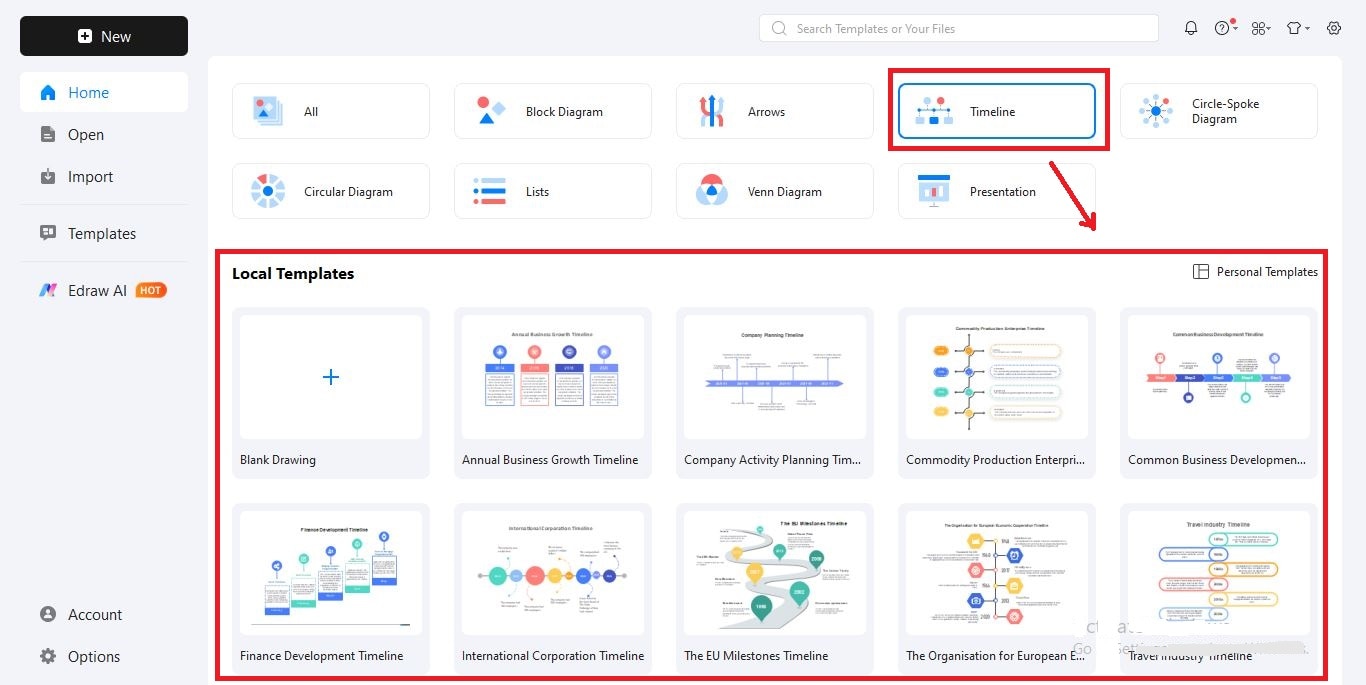
Step3Add and Edit Text
- Go to the Home tab on the top toolbar.
- Click Text to add a title for your timeline.
- To edit existing text, click directly on it and replace it with your dates and descriptions.
- You can adjust the font, size, and color in the Font section of the Home tab or from the floating toolbar.
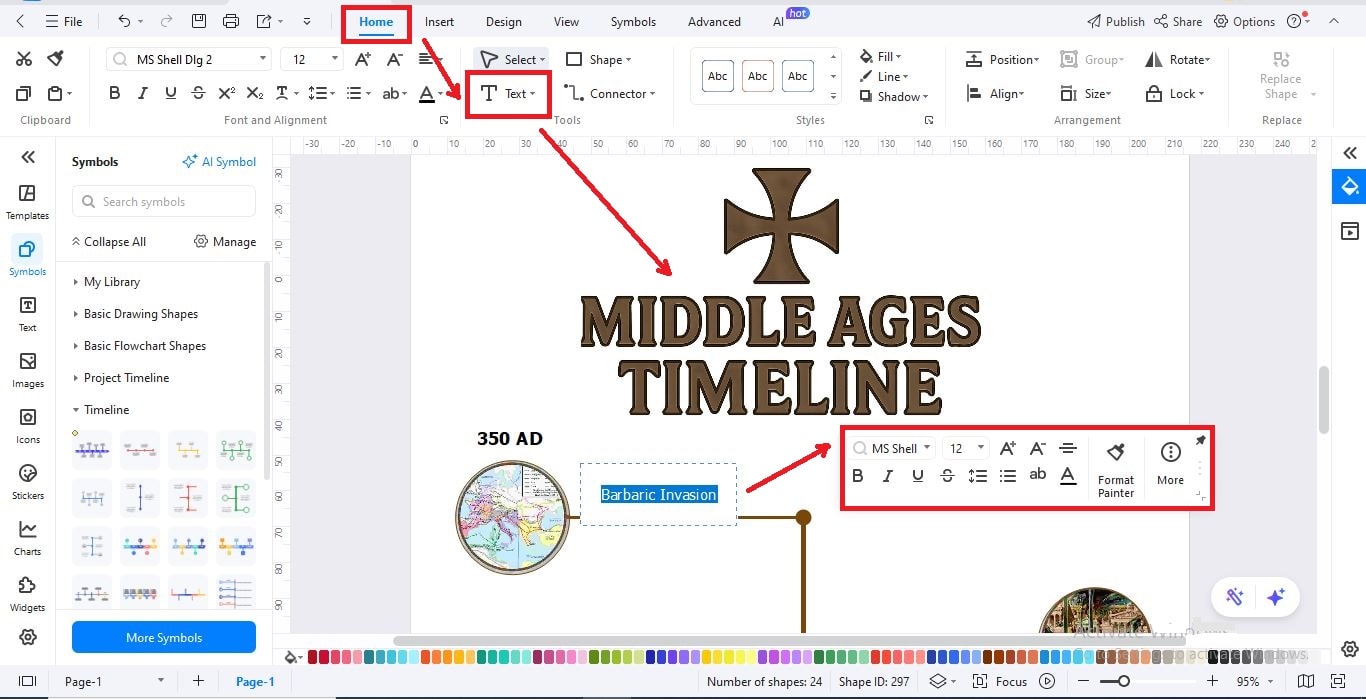
Step4Add Events and Connectors
- In the Home tab, click Shape (middle section) to insert boxes, banners, or event markers.
- To link them, select Connector on the right side of the same tab.
- Use the Select option on the left side to move or resize items on your canvas.
- To add symbols and images, use the panel on the left, and personalized connectors and shapes, use the floating toolbar.
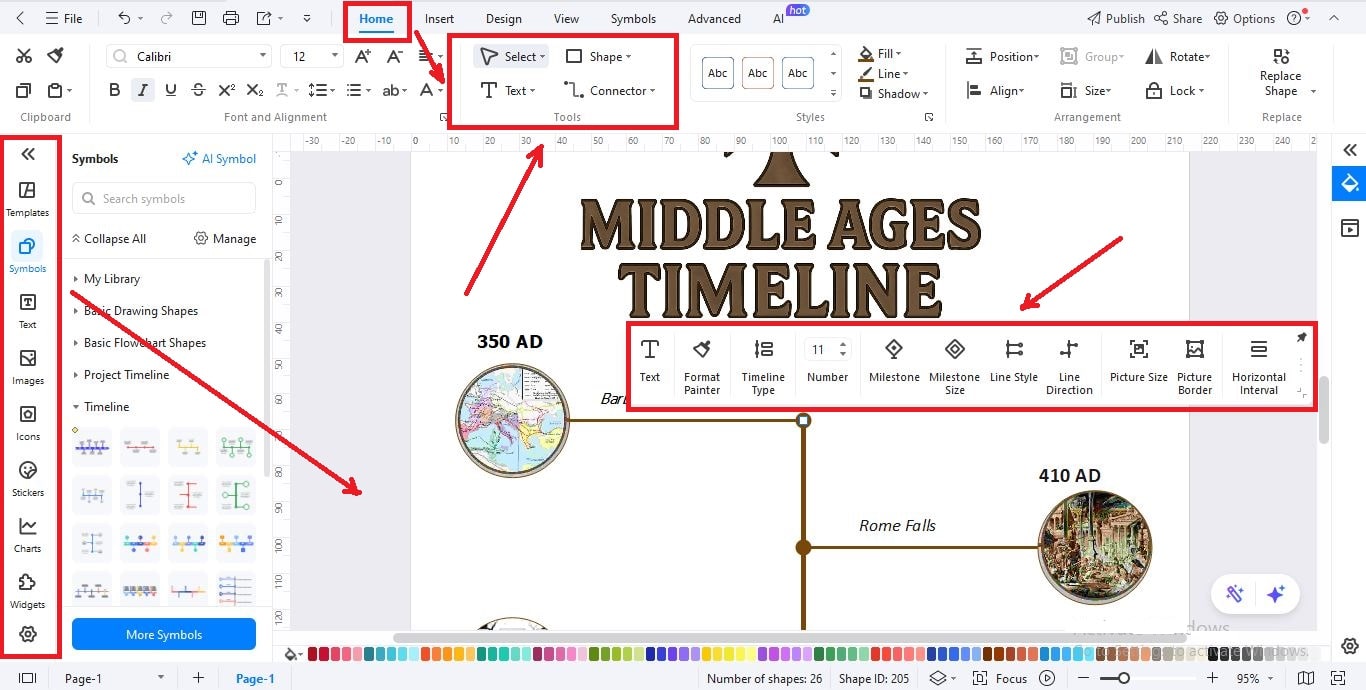
Step5Add Icons, Symbols, and Customize Styles
- On the left panel, click Symbols to access different symbols.
- For more designs, choose More Symbols and search for Middle Ages-related graphics, and drag them into your timeline.
- Select any text, shape, or icon, then use Fill, Outline, and Shadow tools from the Home tab to style them.
- Use Align to position elements neatly, and Group to lock multiple items together.
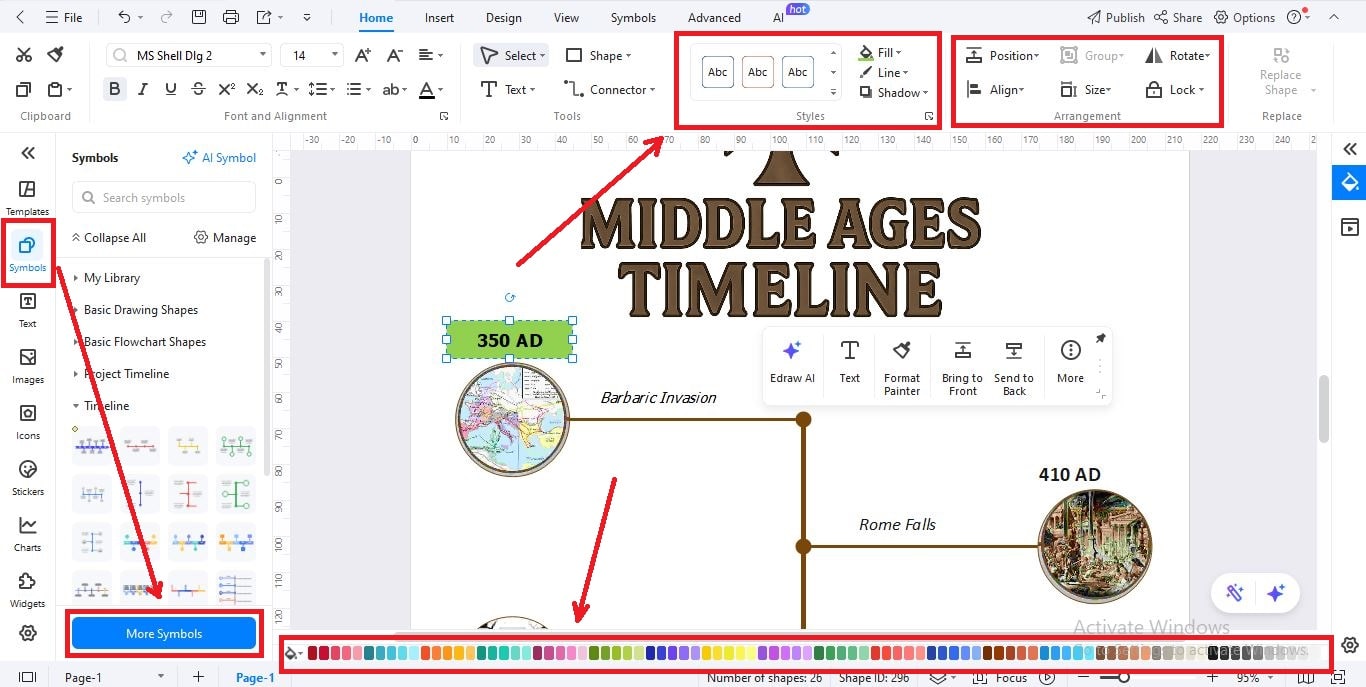
Step6Add a Background Image
- Open the Insert tab and click Picture.
- Choose an image from your computer, EdrawMax’s library, or Google.
- Right-click the image, select Send to Back, lower the opacity, and Lock it via Move the Layer option to prevent changes.
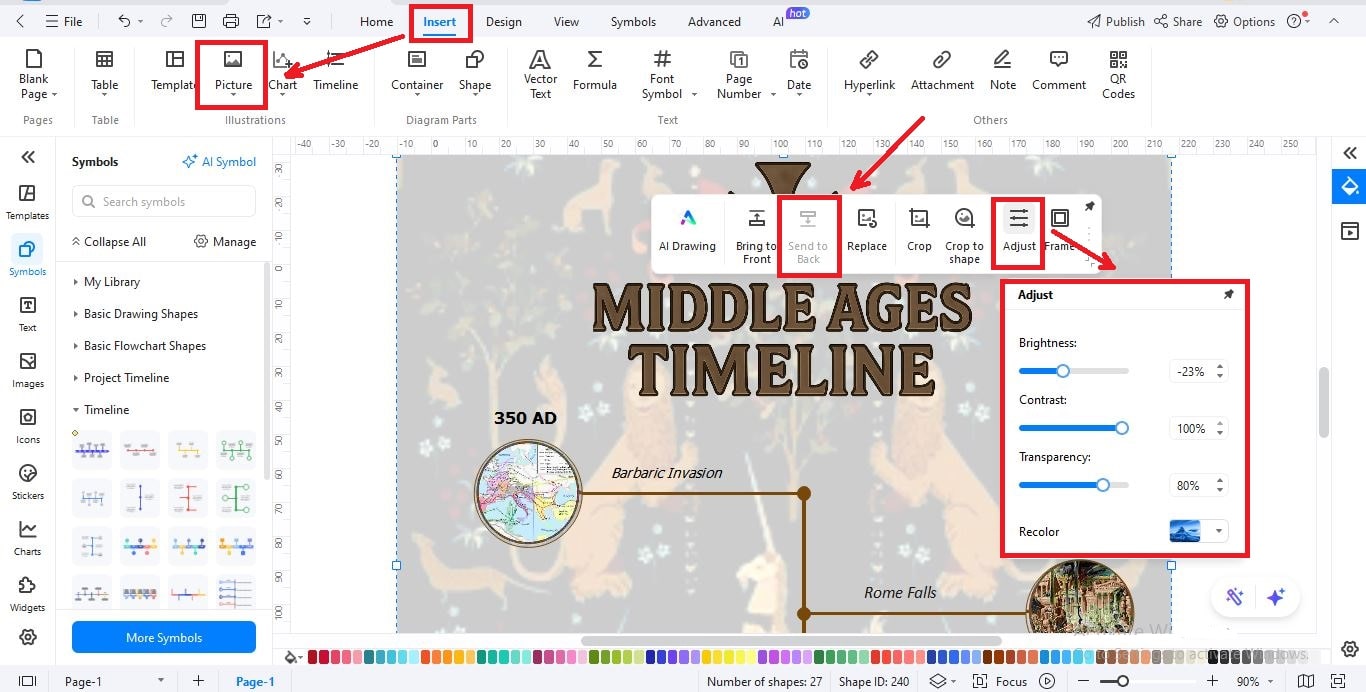
Step7Save, Export, and Share
- When finished, click File > Save to save your work.
- To export your timeline, go to File > Export and pick a format like PNG, PDF, SVG, HTML, Visio, or Excel.
- To share with others, click the Share button and generate a shareable link.
- You can also publish your timeline by clicking the Publish button for others to view.

Closing Remarks
You’ve just traveled through a thousand years of history. The Middle Ages were a time of wars, discoveries, and big changes. Castles were built. Ideas were shared. Power shifted again and again.
Everything that happened in this period shaped the world we live in today. Now you know the start and end of the Middle Ages. So, do you want to see it all laid out? Try EdrawMax. It’s a fun, visual way to make your own timeline in minutes.





